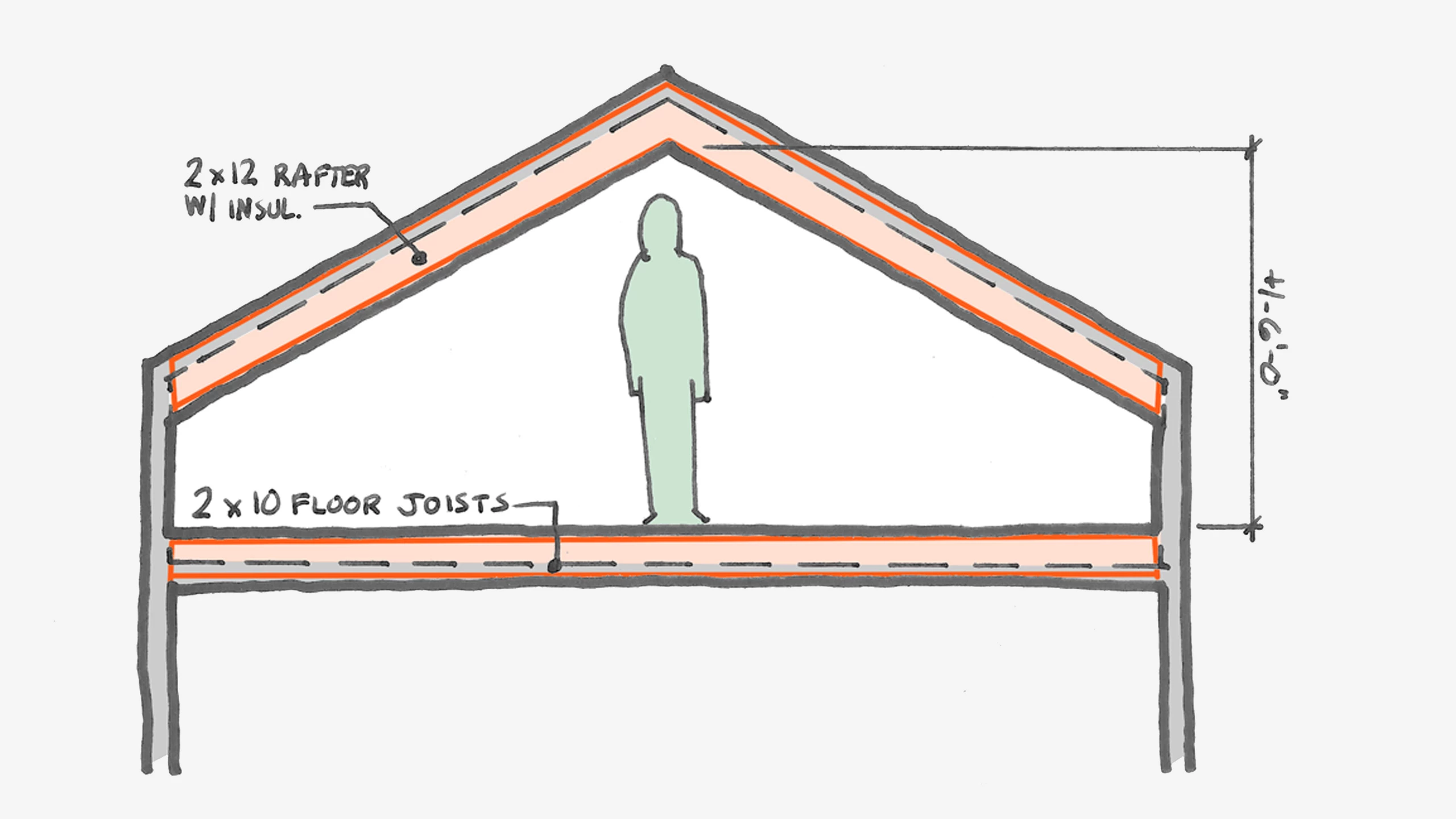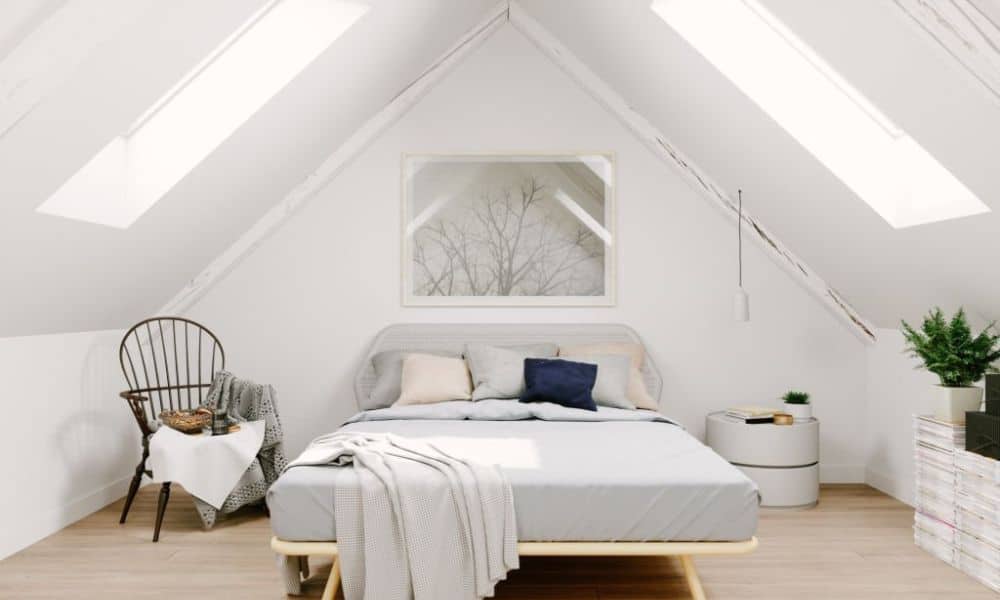Understanding Attic Heat

Attic bedrooms can be unbearably hot, especially during summer months. The unique design of an attic, with its sloped ceilings and limited ventilation, contributes to this problem. Understanding the sources of heat and the factors that influence attic temperature is crucial to effectively cool your attic bedroom.
Primary Sources of Heat
Attic bedrooms are susceptible to several sources of heat, including:
- Sunlight: The roof absorbs solar radiation, directly heating the attic space. Darker roof colors absorb more heat than lighter colors.
- Radiant Heat from the House: Heat from the living spaces below can rise into the attic, particularly if the insulation is inadequate.
- Heat from Appliances: Appliances in the attic, such as water heaters or HVAC equipment, contribute to the overall heat load.
- Heat from Air Leaks: Unsealed gaps and cracks in the attic floor, walls, and roof allow warm air from the house to enter the attic.
Insulation’s Role in Attic Heat
Proper insulation is essential for minimizing heat transfer into the attic. Insulation acts as a barrier, slowing down the flow of heat.
- Insulation Type: Different insulation materials have varying R-values, which measure their resistance to heat flow. Higher R-values indicate better insulation. Common attic insulation materials include fiberglass batts, blown-in cellulose, and rigid foam boards.
- Insulation Thickness: Thicker insulation provides greater resistance to heat transfer. The recommended insulation thickness for attics varies depending on the climate and the specific building code requirements.
- Insulation Placement: Insulation should be installed in the attic floor, walls, and roof to create a continuous barrier against heat transfer. Proper placement ensures the insulation is effective and prevents air leaks.
Roof Material and Attic Temperature, How can i cool down my attic bedroom
The type of roofing material significantly influences attic temperature. Different materials have varying solar reflectance properties, which affect how much heat they absorb.
- Darker Colors: Darker roof colors absorb more solar radiation, leading to higher attic temperatures. Black roofs can reach temperatures up to 150°F (65°C) on a sunny day.
- Lighter Colors: Lighter roof colors, such as white or light gray, reflect more solar radiation, reducing the amount of heat absorbed. White roofs can be up to 50°F (10°C) cooler than dark roofs.
- Reflective Materials: Some roofing materials, such as metal roofs with a reflective coating, are designed to reflect even more solar radiation, minimizing heat absorption. These materials can significantly reduce attic temperatures.
Ventilation’s Impact on Attic Heat
Ventilation plays a crucial role in controlling attic temperature. Proper ventilation allows for the removal of hot air and the introduction of cooler air, preventing heat buildup.
- Soffit and Ridge Vents: Soffit vents, located at the eaves, allow cooler air to enter the attic, while ridge vents, located at the peak of the roof, allow hot air to escape. This creates a natural convection current that draws hot air out of the attic.
- Gable Vents: Gable vents, located on the gable ends of the roof, can also be used to enhance attic ventilation. They provide additional airflow, especially when soffit and ridge vents are insufficient.
- Power Vents: In some cases, power vents, which use fans to force air out of the attic, can be installed to improve ventilation, especially in areas with limited natural airflow.
Cooling Strategies

Keeping your attic bedroom cool requires a multi-pronged approach. There are several cooling methods available, each with its own advantages and drawbacks. Understanding these methods will help you choose the best strategy for your specific needs and budget.
Attic Cooling Methods Comparison
A comparison table can help you visualize the pros and cons of different attic cooling methods:
| Method | Advantages | Disadvantages | Cost |
|—|—|—|—|
| Fans | Affordable, energy-efficient, can be used for natural ventilation | Limited cooling effect, may not be effective in hot climates | Low |
| Air Conditioners | Effective in cooling the entire room, can be programmed for optimal comfort | Higher energy consumption, higher initial cost | High |
| Reflective Paint | Reduces heat absorption, can be cost-effective | May not be as effective as other methods, requires regular maintenance | Moderate |
| Attic Fans | Helps remove hot air from the attic, can reduce overall heat gain | Requires proper installation, may not be suitable for all attics | Moderate |
| Insulation | Prevents heat transfer from the attic to the bedroom, can reduce energy bills | Can be expensive to install, requires professional installation for optimal results | High |
Optimizing Natural Ventilation in an Attic Bedroom
Natural ventilation is a key factor in cooling an attic bedroom. Properly designed ventilation can help draw cool air into the room and exhaust hot air, reducing the overall temperature. Here are some tips to optimize natural ventilation:
– Install attic vents: Ensure your attic has adequate ventilation by installing vents in the soffit and gable ends. These vents allow cool air to enter the attic and hot air to escape.
– Use exhaust fans: Exhaust fans can help remove hot air from the attic, particularly in rooms with limited natural ventilation.
– Open windows strategically: Open windows on opposite sides of the room to create a cross breeze. This helps draw cool air in and hot air out.
– Use window screens: Window screens help keep insects out while allowing air to circulate.
Attic Fan Installation
Attic fans can be an effective way to remove hot air from the attic, reducing the temperature in the bedroom below. However, it’s important to consider the following factors before installing an attic fan:
– Attic size: Attic fans are more effective in smaller attics. A larger attic may require multiple fans.
– Roof pitch: Attic fans are most effective on roofs with a steep pitch. A shallower pitch may require a larger fan.
– Existing ventilation: Ensure your attic has adequate ventilation before installing an attic fan.
– Professional installation: It’s best to have an attic fan installed by a qualified professional. Improper installation can lead to damage and reduced efficiency.
Installing Attic Insulation
Attic insulation is crucial for preventing heat transfer from the attic to the bedroom. It helps keep your bedroom cool in the summer and warm in the winter. Here’s a step-by-step guide to installing attic insulation:
1. Prepare the attic: Clear the attic of any obstructions, such as furniture or boxes.
2. Measure the attic space: Measure the area you need to insulate.
3. Choose the right insulation: Select insulation that is appropriate for your climate and attic space.
4. Install the insulation: Follow the manufacturer’s instructions for installing the insulation.
5. Seal any gaps: Seal any gaps or cracks in the attic floor to prevent air leaks.
Interior Cooling Measures: How Can I Cool Down My Attic Bedroom

Beyond attic insulation and ventilation, several interior cooling measures can help keep your attic bedroom comfortable. By making smart choices about your furnishings, window treatments, and appliances, you can significantly reduce heat buildup and create a more pleasant living space.
Light-Colored Fabrics and Materials
Choosing light-colored fabrics and materials for your attic bedroom can contribute to a cooler environment. Light colors reflect more sunlight, reducing the amount of heat absorbed by the room.
- Fabrics: Opt for light-colored bed linens, curtains, and upholstery. White, cream, light gray, and pale blue are excellent choices.
- Materials: Consider using light-colored wood furniture, rugs, and flooring. Natural materials like cotton and linen are breathable and help regulate temperature.
Impact of Window Coverings
Window coverings play a crucial role in regulating the temperature of your attic bedroom. They can help block out sunlight and reduce heat gain, especially during the hottest parts of the day.
- Blinds and Shades: Light-colored blinds or shades, particularly those made from reflective materials like aluminum, can effectively reflect heat away from the room.
- Curtains: Thick, dark-colored curtains can block out sunlight but can also trap heat. Consider using light-colored curtains with a thermal lining to provide insulation and prevent heat gain.
Energy-Efficient Appliances
Using energy-efficient appliances can help reduce heat generated within your attic bedroom. These appliances consume less energy, resulting in less heat output.
- Refrigerator: Choose a refrigerator with an Energy Star rating, which indicates high energy efficiency.
- Air Conditioner: If you rely on an air conditioner, opt for an Energy Star-rated model to minimize energy consumption and heat generation.
- Lighting: Replace traditional incandescent light bulbs with LED bulbs, which produce less heat and are more energy-efficient.
Benefits of Using a Dehumidifier
A dehumidifier can be a valuable tool for managing humidity in your attic bedroom. High humidity can make the room feel hotter and uncomfortable.
- Reduces Humidity: Dehumidifiers remove excess moisture from the air, reducing the perceived temperature and creating a more comfortable environment.
- Prevents Mold Growth: High humidity can encourage mold growth, which can pose health risks. A dehumidifier can help control humidity levels and prevent mold formation.
How can i cool down my attic bedroom – Battling the heat in an attic bedroom can feel like an uphill battle, especially when the summer sun beats down relentlessly. If you’re looking for a cooler escape, perhaps it’s time to consider a more temperate living space, like a one bedroom apartment in Milledgeville, GA.
With a little research, you can find a cozy apartment that’s both affordable and cool, leaving your attic bedroom woes behind.
Cooling down an attic bedroom can be a challenge, especially during the summer months. While a fan might help, consider incorporating a built-in bedroom desk to create a more efficient workspace. This will free up floor space, allowing for better air circulation and a more comfortable environment.